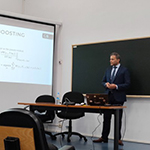In the field of computer vision and image segmentation, U-Net has emerged as a powerful and widely
used architecture. U-Net has proven to be highly effective for tasks such as image segmentation,
where the goal is to classify each pixel in an image. This tutorial will provide a comprehensive
overview of U-Net architecture, its components, and how to implement it for image segmentation
tasks.
...
In the vast realm of machine learning, the concept of latent space holds a significant position.
Latent space is a mathematical representation of data where similar items are grouped, making it a
powerful tool for various applications such as image generation, language processing, and more. In
this tutorial, we will review the complexities of latent space, exploring its definition,
applications, and how it can be leveraged to enhance the capabilities of machine learning models.
...
Reinforcement learning pipelines are a way to automate the process of training and deploying
reinforcement learning agents. They typically consist of the following steps:
Environment, Agent, State, Action, Reward, Policy, Value function, Models, and Hyperparameters.
...
ext feature extraction is the process of converting raw text data into a numerical or structured
format that can be used as input for machine learning algorithms, statistical analysis, and various
other data-driven tasks. Text data, in its natural form, is challenging for many algorithms to
process directly because they typically require numerical input. Feature extraction transforms text
data into a more suitable representation while retaining meaningful information.
...
When working on machine learning projects, one of the challenges is often how to make the models
accessible and usable by users who may not have a technical background. Gradio addresses this
challenge by providing a high-level interface that abstracts away the complexities of web
development, enabling users to focus on the core functionality of their models.
...
